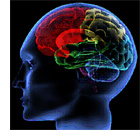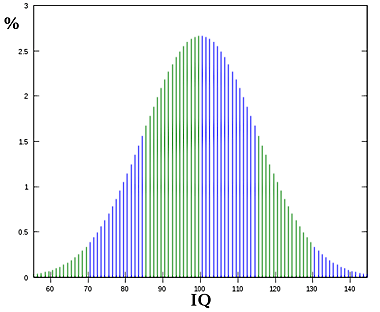Measuring Intelligence: A Brief History
8.2.2010
The measurement of intelligence is something that has plagued psychologists for decades. Having battled with the ambiguity of what intelligence actually is (there are numerous contrasting definitions) the ability to create boundaries and impose limitations on the subject is a strenuous task. Nonetheless, over the years numerous academics have attempted to form a strategic method in which to measure intelligence, some of which have been more successful than others.
Alfred Binet
 In 1905, France gave birth to what was fundamentally the first (successful) method of measuring intelligence. Following the need to establish specialist schools for children with learning difficulties, the French Government employed Alfred Binet to produce a system in which schools might distinguish between those who were intellectually challenged and those who were able. The method Alfred Binet delivered, along with the assistance of Theophile Simon, required children to complete a simple exam in which they would copy shapes or patterns, name objects and follow straightforward instructions. Alfred's initial influence in the science of measuring intelligence was however, short-lived: Binet did not believe that intelligence was quantitative, and stated that: "Some recent thinkers seem to have given their moral support to these deplorable verdicts by affirming that an individual's intelligence is a fixed quantity, a quantity that cannot be increased. We must protest and react against this brutal pessimism.... "Indeed, Binet dreaded that his method of measuring intelligence would mean that children were being considered to be at a standard which they could not surpass, and thus encouraged the tests to be abandoned. Nonetheless, the test went ahead and was first piloted in the schools in Paris, the results of which founded the standard boundaries implemented in the measurement process- i.e. if a large percentage of a certain age group passed a test, that percentage was then taken to represent the average level of intelligence within that age group, and consequently the concept of mental ability was established: today we recognise that it is possible to be thirty years old, but still only have the mental age (MA) of a nine year old - a concept that has been hugely influential in the study of mental illness.
In 1905, France gave birth to what was fundamentally the first (successful) method of measuring intelligence. Following the need to establish specialist schools for children with learning difficulties, the French Government employed Alfred Binet to produce a system in which schools might distinguish between those who were intellectually challenged and those who were able. The method Alfred Binet delivered, along with the assistance of Theophile Simon, required children to complete a simple exam in which they would copy shapes or patterns, name objects and follow straightforward instructions. Alfred's initial influence in the science of measuring intelligence was however, short-lived: Binet did not believe that intelligence was quantitative, and stated that: "Some recent thinkers seem to have given their moral support to these deplorable verdicts by affirming that an individual's intelligence is a fixed quantity, a quantity that cannot be increased. We must protest and react against this brutal pessimism.... "Indeed, Binet dreaded that his method of measuring intelligence would mean that children were being considered to be at a standard which they could not surpass, and thus encouraged the tests to be abandoned. Nonetheless, the test went ahead and was first piloted in the schools in Paris, the results of which founded the standard boundaries implemented in the measurement process- i.e. if a large percentage of a certain age group passed a test, that percentage was then taken to represent the average level of intelligence within that age group, and consequently the concept of mental ability was established: today we recognise that it is possible to be thirty years old, but still only have the mental age (MA) of a nine year old - a concept that has been hugely influential in the study of mental illness.
Lewis Terman and Robert Yerkes
Although Binet was widely acclaimed for establishing the Mental Age, it was not long before researchers of this pseudo-science realised that it was essential to measure the difference between the chronological age and the MA-something Binet had not considered. In 1912 William Stern proposed the idea in his publication The Psychological Methods of Intelligence Testing that the Mental Age of an individual should be divided by the Chronological age and then multiplied by one hundred. Scientifically, the division of one quantity by another is known as a quotient, and as a result the science of measuring science became fashionably known as Intelligence Quotient, or IQ testing. The inclusion of an IQ in mental tests was adopted by Terman in his 1916 review of Alfred Binet's work- a project he had been working on during his time at Stanford University.
 The scale was such a success in America that Robert Yerkes, the President of the American Psychological Association, decided to apply the theory to U.S Army recruits. Recruits joining the U.S army after the publication of this test were subjected to a basic verbal test, known as the Alpha test. The test was adapted to the military requirements and was intended to distinguish what level of training an individual could be subjected to. Recruits who performed poorly went on to take a further non-verbal test- the Beta test. Although these methods of examination were at the time considered to be sophisticated, research following the War suggested that the average MA of a First World War recruit was thirteen years old, and thus the problems of generalisation came to light. The tests forced researchers to acknowledge that variables of intelligence were problematic to the measurement of intelligence: the recruits of the First World War all came from varying levels of education, diverse home environments, and alternative societies; although some men were uneducated, they were not profoundly stupid. Therefore, the presumption that those who failed the Alpha test were struggling with speech difficulties was unforgivably short-sighted.
The scale was such a success in America that Robert Yerkes, the President of the American Psychological Association, decided to apply the theory to U.S Army recruits. Recruits joining the U.S army after the publication of this test were subjected to a basic verbal test, known as the Alpha test. The test was adapted to the military requirements and was intended to distinguish what level of training an individual could be subjected to. Recruits who performed poorly went on to take a further non-verbal test- the Beta test. Although these methods of examination were at the time considered to be sophisticated, research following the War suggested that the average MA of a First World War recruit was thirteen years old, and thus the problems of generalisation came to light. The tests forced researchers to acknowledge that variables of intelligence were problematic to the measurement of intelligence: the recruits of the First World War all came from varying levels of education, diverse home environments, and alternative societies; although some men were uneducated, they were not profoundly stupid. Therefore, the presumption that those who failed the Alpha test were struggling with speech difficulties was unforgivably short-sighted.
The Stanford-Binet method of intelligence measuring has since been reviewed five times, resulting in the Stanford-Binet 5 method, which tries to take into account the variables of society, and is still in effect in the U.S today.
David Wechsler
In 1939 David Wechsler produced an alternative form of measuring intelligence- he felt that previous ideas had focussed too much on the verbal capabilities of an individual, and that the more diverse attributes possessed by candidates were being ignored. Wechsler believed that intelligence was firmly linked to personality, ambition and personal tastes; he did not agree that it was possible to create a generic level of intelligence. Therefore, Wechsler incorporated Performance Tasks into his test programme to combat the limitations of the previous intelligence tests. Initially, his programme was devised of two sections but resulted in three different IQ results: the first part if the test was essentially the same as the Stanford-Binet method, in that it was purely a verbal test, whilst the second part was purely performance tasks. Both parts resulted in individual IQ levels, and the third was provided when the average was taken of the first two. Today there are three different forms of Wechsler Intelligence test; the first is specifically aimed at children between the ages of three and seven years old (Wechsler Pre-school and Primary Scale of Intelligence). The second is devised for those between seven and sixteen years old (Wechsler Intelligence scale for Children), and the final was intended for sixteen year olds and above (Wechsler Adult Intelligence Scale). The first publication of Wechsler's methods was in 1939 with the Wechsler-Bellevue Intelligence Scale; this was later replaced with the Wechsler Adult Intelligence Scale (WAIS) in 1955. The principles of the test have remained the same- the test is still divided into two sections, however the content of those two sections has over time been altered.
Naturally, as the intelligence measurement phenomenon has amplified, numerous other methods of measuring intelligence have been founded. Along with the IQ craze, came a profound debate about the ethics and legitimacy of the "science"- concerns as to whether or not the subject can be considered a science are frequently voiced by psychologists of today. Nonetheless, one thing that all researchers of the subject can agree on is that the history of the pseudo-science is fascinating, and undoubtedly a consequence of the hard work and impressive consideration of the psychologists of the past.